Quiche Lorraine is one of my family’s favorite things to eat. I’m a fan because it’s simple to assemble and bake. Eggs, milk, cheese, and bacon baked in pie crust. What’s hard about that? My family loves it because it’s a versatile dish. They get away with eating it for breakfast, lunch, and dinner. If you haven’t jumped on the quiche Lorraine train yet, you’re about to.
On a totally unrelated, yet important note: a squirrel has found its way into the attic and is currently moving its furniture in. I’m writing on about 23 seconds of sleep that I got in between the pitter-patter of his little feet last night. Something must be done. In the meantime, forgive me for any typos.

What is a Quiche?
Quite simply, a quiche Lorraine is a savory custard. A custard is a mixture of cream and eggs. To make a quiche, mix in meats and cheese into an egg and cream mixture instead of adding sweet-ish ingredients like vanilla and sugar. Some folks make crustless quiches; others, like me, can’t live without a crust. You can add veggies, herbs or swap out the meat for seafood.
In short, if they have crusts, quiches are savory pies. No crust? They’re omelets. Baked omelets, but omelets nevertheless.
Where does Quiche come from?
Quiches are a French recipe named after a German cake. Confused much?
Kuchen is German for “cake” or “little cake.” At its essence, a quiche is a little egg cake. Now it makes a bit more sense, no? The birthplace of this particular quiche recipe will help the name make even more sense.
What is a Quiche Lorraine?
The Quiche Lorraine is from the Lorraine region of France, which is just a hop, skip, and jump from the German border. You know how I know? Because while we were living in Germany, we used to make the 45-minute drive to Metz (a city in the Lorraine region) just to buy bread.
In our jaunts across the border, I came to know and love Quiche Lorraines. One of the most important things I learned- from a very stern cook called Gabrielle- was that “Americans mess up quiche Lorraine all the time.” Okay, Gabby. Tell us how you really feel.
According to Gabrielle, we overdo it with the fillings. In Lorraine, a quiche really only needs the egg and cream custard, onion, and maybe cheese. When I asked about adding meats and veggies, she gave me this eye roll/sigh combination.
“See? Too much.” She conceded that bacon-she actually said speck because, according to her, bacon is “déchets,” which I later found out meant trash. Which, I mean, even Gabby can be wrong.
What do I need to make Quiche Lorraine?
To make a “semi-Gabby acceptable” Quiche Lorraine, start with buttery pie dough. For the custard, grab egg yolks, half-and-half, bacon (because she’s still wrong), gruyere cheese, and chives. Seasonings like salt and pepper and a pinch of nutmeg will complete the dish.
A quiche pan is a tart pan with a false (or removable) bottom. That’s the way you get that beautiful fluted edge. Quiches are thin, not thick like a fruit pie. Most quiche pans are only 1-inch tall, though I was able to find one with 2-inch sides.
What type of crust do I use for quiche?
Pie dough is great to use when making this recipe. My Flaky Pie Dough makes enough to prepare two of these quiches. You can freeze one disc of dough for a future quiche while you prepare this one, or just double this quiche recipe and use up both discs of dough.
You can also use a prepared pie dough from the store to make this recipe. Make sure it’s enough to roll out into a 13-inch circle, though.
Can I use a pie plate instead of a tart pan?
If you don’t have a tart pan with a removable bottom, use a pie plate. I recommend a metal pie tin because they conduct heat more evenly, which means your crust will brown properly. To me, there’s nothing worse than eating a quiche lorraine that has a gummy crust. The bottom should be as brown as the edges.
Make sure your pie tin is at least 9-inches in diameter and 3-inches deep. Because most pie tins are 9-inches, you need something that’s deep to hold the egg custard.
How do I blind bake a pie shell?
Since I will post a more in-depth tutorial on how to blind bake a pie crust, this will be hard and fast.
Roll out that portion of Flaky Pie Dough (remember, half of my recipe is enough for this 11-inch Quiche) into a 13-inch circle. Place the tart pan you’re going to use right in the center of the dough to ensure it’s large enough to go up the sides.
Roll the dough back onto the rolling pin, then unroll it over the tart pan. Lift up the edges of the pie dough and allow it to fall naturally into the pan. You don’t want to stretch or force it into the pan because that will cause it to shrink as it bakes.
Once the dough is laid into the pan, press it against the sides. If you have an overlapping dough, fold it back and tuck it between the dough and the tart pan. Press the dough to seal it to the sides of the pan. Do this all around the tart pan. You can flute the edges like a regular pie if you’re feeling fancy.
Use the tines of your fork to poke holes into the bottom of the pie dough. These holes allow the dough to vent the steam it creates as it bakes, preventing it from puffing and distorting.
Once the holes are poked, refrigerate the dough for 30 minutes to firm up the butter.
How long do I blind bake the pie shell?
After chilling, place a piece of aluminum foil into the center of the pie shell. The foil should be large enough to cover the entire shell.
Fill the foil lining with dried beans, uncooked rice, sugar, or a lot of ceramic pie weights. Press them into the corners of the shell to ensure they’re weighing down all of the dough.
Place the pan onto the center rack of an oven preheated to 400°F (204°C) and bake for 20 minutes. After 20 minutes, remove the pan, then carefully remove the foil liner and the weights. Return the pie dough to the oven and bake for an additional 8-10 minutes, or until golden brown. It’s okay if the shell puffs slightly, but it shouldn’t develop large bubbles.
Baking with the pie weights prevents the dough from sinking down into the pan. The holes we poked into the dough prevent the dough from blistering and distorting as it bakes. The weights also help mitigate any bubbles from blowing too big.
If you find your shell is sinking, it’s because there weren’t enough weights in the shell before baking. You can get a large number of dried beans on the cheap, and they can be reused 4 or 5 times. You need to fill your shell up about 3/4s of the way to make sure it stays put.
Once your shell is baked, you can leave it at room temperature to cool. You can blind bake your quiche crust a day ahead and store it, covered, in the fridge as well.
Lower the oven’s temperature to 375°F (190°C) while you’re messing with it.
Do I cook the bacon before adding it to the Quiche Lorraine?
Before you add the bacon (or raw speck) to the quiche custard, you need to cook it until crisp.
Whichever method you prefer to obtain bacon crumbles is your business, but I like chopping mine, then cooking them. I do this because when I fry or bake them in strips, I tend to eat more than I crumble. I have no self-control.
Place the chopped bacon into a cold skillet. Turn the heat to medium-high and slowly brown the bacon for 13-15 minutes. Use a spoon or spatula to break the bacon apart, so it cooks evenly.
Once the bacon is browned and crisp, use a slotted spoon to remove it from the pan to a paper towel-lined dish. Allow the paper towels to soak up any excess grease.
Set the bacon aside while you assemble the Quiche.
What else can I use besides half and half?
I drink half-and-half in my coffee every morning, so I always have it on hand. There are a few ways you can alter this recipe if you don’t have any, though.
- mix 1 cup (250 milliliters) heavy cream with 1 cup (250 milliliters) whole milk
- use 2 cups (500 milliliters) of heavy cream
- replace the half-and-half with whole milk
- use 2 cups (500 milliliters) of evaporated milk instead of half-and-half
There’s no real vegan substitute in this recipe because it’s an egg, cheese, and bacon custard. So…I’m sorry about that.
Combine the egg yolks, chives, half-and-half, salt, pepper, and nutmeg together in a mixing bowl using a whisk. Whisk this mixture for one full minute until it is light and frothy.
Do I have to add cheese?
Sprinkle the cooked bacon onto the baked pie crust in an even layer. Make sure it’s a fair disbursement, or your family will lose their ever-loving minds.
Next, scatter the shredded gruyere on top of the bacon. If you don’t have or like gruyere, use a similar gooey, mild cheese like gouda or fontina.
You can also omit the cheese altogether. I will have to check in with Gabby to see if it’s still suitable to be called a quiche Lorraine, but I’ll vouch for you.
I don’t like Nutmeg. Can I omit it?
I’ve heard this from a lot of my friends. It’s usually preceded by, “EWWWWW!!! Why would I add nutmeg to my eggs?!?!” I usually respond with a roll of the eyes, then with, “Because, Friend, nutmeg highlights the creaminess of the half-and-half and the cheese. It’s good.”
They don’t believe me until they actually taste it (fancy that), then they’re all, “I knew it would taste good.” Which elicits another eye roll from me.
Even if you think you hate nutmeg, add it. It’s such a minuscule amount that you have to be a superhero to even detect it’s in there (unless you made it, then of course you know it’s in there). If you’re allergic to nutmeg, you get a pass. If you’re not, I want you to try it. Do it because you love me, okay?
Quiche Lorraine Swaps and Subs
Meat Subs:
- chopped speck (no need to cook it if it’s cured)
- cooked, diced ham
- cooked, diced turkey
- chopped prosciutto
- chopped pancetta
Cheese Subs (shred all):
- gouda
- fontina
- swiss
- Emmentaler
- Havarti
- any smoked variety of the above or gruyere
Fresh Herb Swaps (use 1 tablespoon of one):
- chopped parsley
- dill
- basil
- oregano
- sage
For a lighter quiche, replace 3 of the egg yolks with 2 whole eggs or substitute the half-and-half for whole milk.
How long do I bake the quiche?
After the bacon and cheese are scattered into the pie crust, give the egg mixture another vigorous whisk.
Carefully and slowly, pour the egg mixture into the pie shell. If you see the mixture is going to overflow, stop pouring and shimmy the pan a little. Sometimes the cheese and bacon form a dam, and you need to help the eggs get around it. Once all of the egg mixture is poured, carrrrrrrrefully slide the pan into the oven.
If you’re clumsy like I sometimes am, you might want to put the pan onto a thin sheet pan before pouring the egg mixture in. This will help you transfer the pan to the oven easier. This is also a good idea if your pan is super shallow. It’ll help catch any spills should the custard overflow the pan while baking.
If you think you can slide it into the oven on its own, remember that the pan has a false bottom. Don’t push up into the center of the pan like you would a cake pan. Instead, grip it from the bottom sides, not from the bottom middle.
Bake the quiche lorraine in that preheated oven for 30 minutes or until the center is set. The internal temperature should be around 175°F (79°C), give or take 5 degrees.
My Quiche Lorraine is still wobbly in the center. What do I do?
When fully baked, the Quiche shouldn’t jiggle as my belly does. It must be firm but not cracked (which means it’s overcooked). If it’s still jiggly when you tap it, bake it for another 5 minutes. Check its jiggle factor every 5 minutes until it’s set.
Remove the Quiche from the oven once it is baked. Don’t forget to mind that false bottom! The Quiche should be lightly browned on the surface, and the crust should be golden brown.
Allow the Quiche to cool slightly or completely, depending on your eating preferences. I’m a fan of room temperature quiche, but the rest of my brood likes theirs piping hot. So, we eat it at room temperature because what I say goes.
How do I serve the Quiche Lorraine?
I serve my Quiche Lorraine with fresh fruit when I’m serving it for breakfast. For brunch, lunch, or dinner, I serve it with a simple garden salad and a light vinaigrette.
I often hear from people that they don’t like Quiche that’s thin. This is one thing I’ve adopted from Gabby. Quiche Lorraine shouldn’t be this thick, honking slice of pie. It’s a rich, meaty custard and, as such, should be a thin, delicate layer on top of rich, buttery crust. The French know how to eat, so we need to heed their advice.
How do I store leftovers?
Wrap leftover Quiche and refrigerate it for 3 days. Then, when you’re ready to eat it, you can reheat it in a 350°F (177°C) oven or in a microwave until warmed through.
You can also eat it cold, straight from the fridge.
Can I freeze Quiche Lorraine?
You can most certainly freeze quiche Lorraine.
Wrap it well in foil or plastic film and store it in the freezer for 2 months. Thaw it in the fridge or reheat it from frozen in a preheated 350°F (177°C) oven.
Enjoy this Quiche Lorraine, and don’t forget to share it. I have no idea where that squirrel is, but it’s getting its eviction notice richt’neow! Pray for me because I’m scared of wildlife.
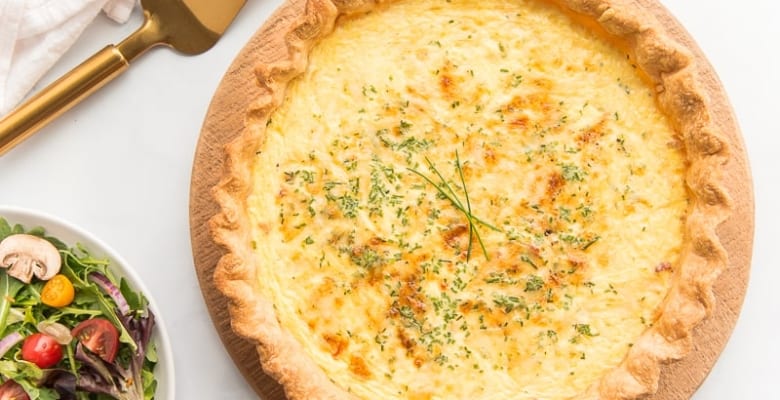
Easy Quiche Lorraine
at Sense & EdibilityEquipment
- 11-inch tart pan with removable bottom or 9 or 10-inch pie tin
- rolling pin
- ceramic pie weights or 2 pounds of dried beans
Ingredients
- 1 pound (464 grams) flaky pie dough blind baked* (or 1/2 of this recipe)
- 12 ounces (340 grams or 15 slices) bacon chopped
- 8 ounces (226 grams or 3 cups) gruyere cheese shredded
- 9 large egg yolks
- 1 tablespoon chives minced, plus more to garnish (optional)
- 3/4 teaspoons (4 1/2 grams) kosher salt
- 1/4 teaspoon black pepper
- pinch ground nutmeg
- 2 cups (500 milliliters) half and half
Instructions
Cook the Bacon
- Preheat your oven to 375°F (190°C).Place the chopped bacon into a cold skillet. Turn the heat to medium-high and slowly brown the bacon for 13-15 minutes, using a spoon or spatula to break the bacon apart, so it cooks evenly.
- Once the bacon is browned and crisp, use a slotted spoon to remove it from the pan to a paper towel-lined dish. Allow the paper towels to soak up any excess grease.Set the bacon aside while you assemble the rest of the Quiche.
Assemble the Pie Shell
- Once the bacon is cool to the touch, sprinkle it evenly in the bottom of the baked pie shell.Cover the bacon with the shredded gruyere.
Mix the Quiche Custard
- Combine the egg yolks, chives, half-and-half, salt, pepper, and nutmeg together in a mixing bowl using a whisk. Whisk the mixture for one full minute until it is light and frothy.
- Carefully and slowly, pour the egg mixture into the pie shell. If the mixture is starts to overflow the tart pan, stop pouring and shimmy the pan a little. Once all of the egg mixture is poured, carrrrrrrrefully slide the pan into the oven. Putting the pan onto a thin sheet pan before pouring the egg mixture in will help you transfer the pan to the oven easier. This is also a good idea if your pan is super shallow. It'll help catch any spills should the custard overflow the pan while baking.
Bake the Quiche Lorraine
- Bake the quiche Lorraine in the preheated oven for 30 minutes or until the center is set. The internal temperature should be between 170°-180°F (76-82°C). When fully baked, the quiche will be firm but not cracked. If it's still jiggly when you tap it, bake it for another 5 minutes. Check for doneness every 5 minutes until it's set.
- Remove the Quiche from the oven once it is baked. The Quiche should be lightly browned on the surface, and the crust should be golden brown.
- Allow the Quiche to cool slightly or completely, depending on your eating preferences.Serve with fresh fruit or a side salad.
Notes
*see post for blind baking instructions
Swaps and Subs:
Half and Half Subs:
- mix 1 cup (250 milliliters) heavy cream with 1 cup (250 milliliters) whole milk
- use 2 cups (500 milliliters) of heavy cream
- replace the half-and-half with whole milk
- use 2 cups (500 milliliters) of evaporated milk instead of half-and-half
Bacon Subs:
- chopped speck (no need to cook it if it's cured)
- cooked, diced ham
- cooked, diced turkey
- chopped prosciutto
- chopped pancetta
Cheese Subs (shred all):
- gouda
- fontina
- swiss
- Emmentaler
- Havarti
- any smoked variety of the above or smoked gruyere
Swaps for Fresh Chives (use fresh herbs):
- chopped parsley
- dill
- chopped basil
- oregano
- chopped sage
Swaps:
- For a lighter quiche, replace 3 of the egg yolks with 2 whole eggs or substitute the half-and-half for whole milk.
Tips and Storage Instructions:
- If you think you can slide the tart pan into the oven on its own, don't forget that the pan has a false bottom. Don't push up into the center of the pan like you would a cake pan. Instead, grip it from the bottom sides, not from the bottom middle.
- Wrap leftover Quiche and refrigerate it for 3 days. Then, when you're ready to eat it, you can reheat it in a 350°F (177°C) oven or in a microwave until warmed through or eat it cold, straight from the fridge.
- To freeze quiche Lorraine:
- Wrap it the cool quiche well in foil or plastic film.
- Store it in the freezer for 2 months.
- Thaw the quiche in the fridge overnight or reheat it from frozen in a preheated 350°F (177°C) oven.

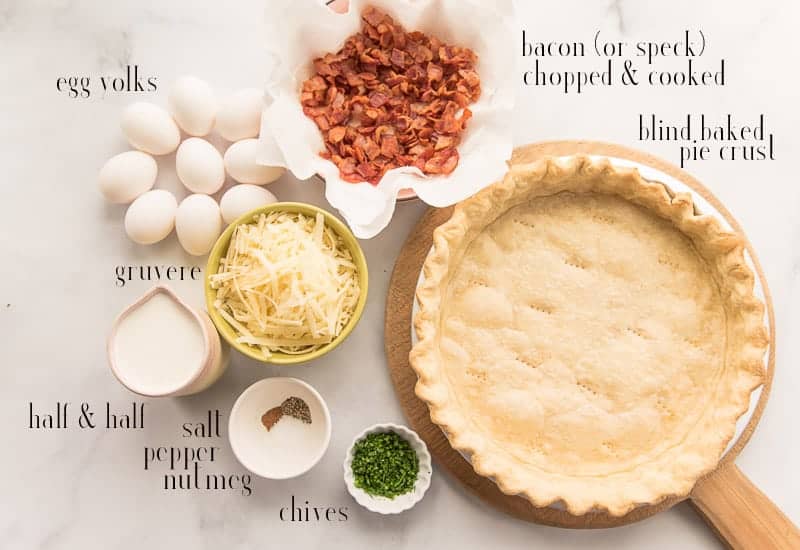
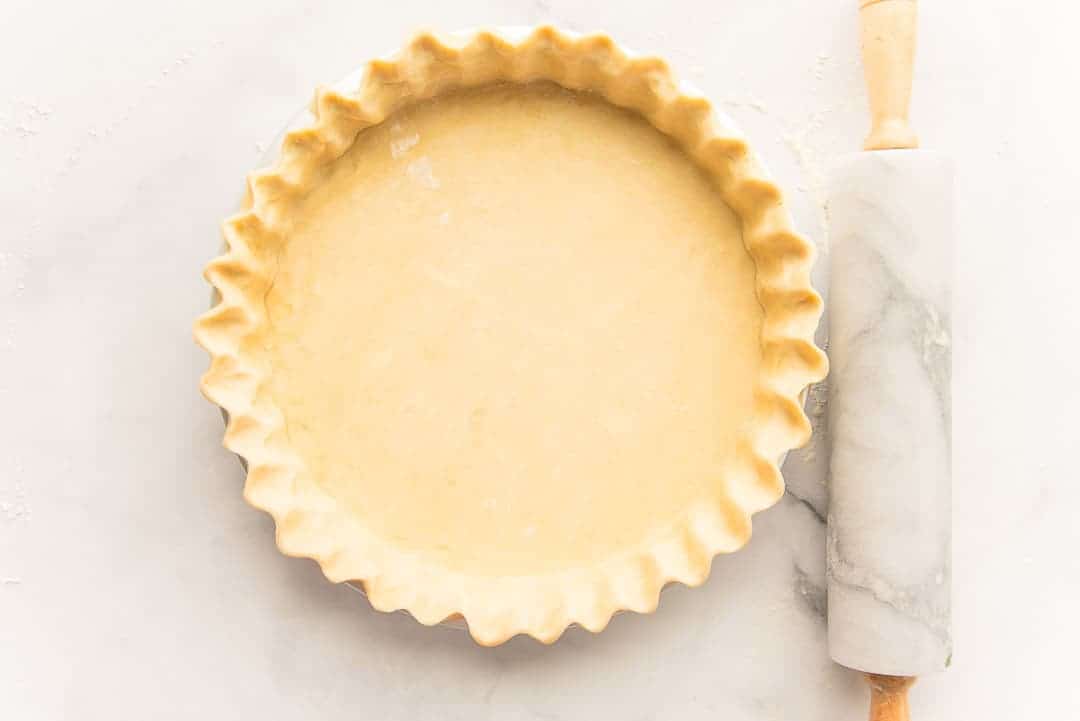
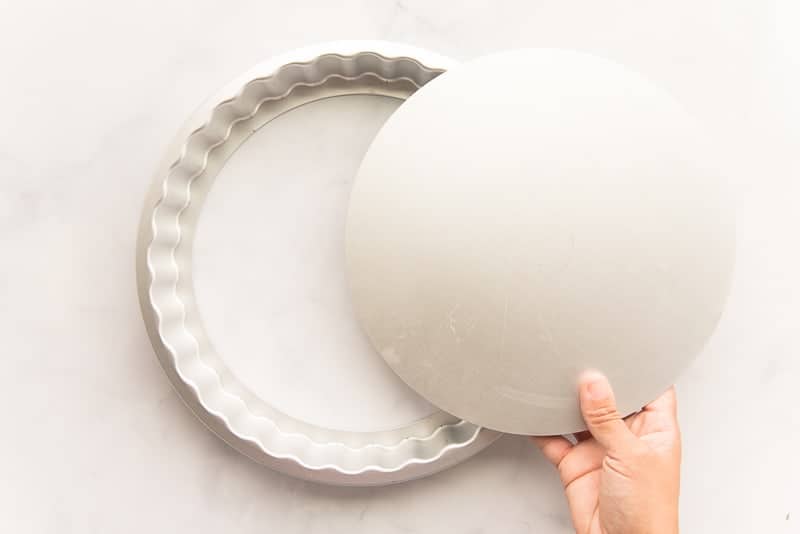
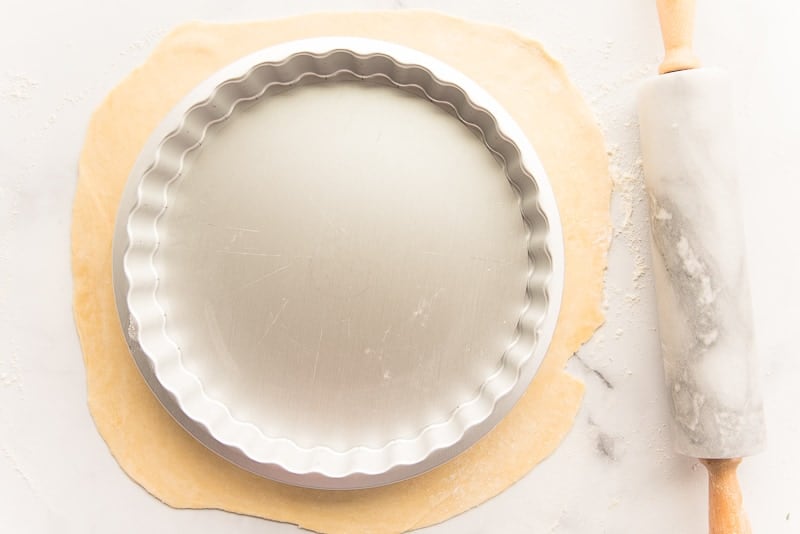
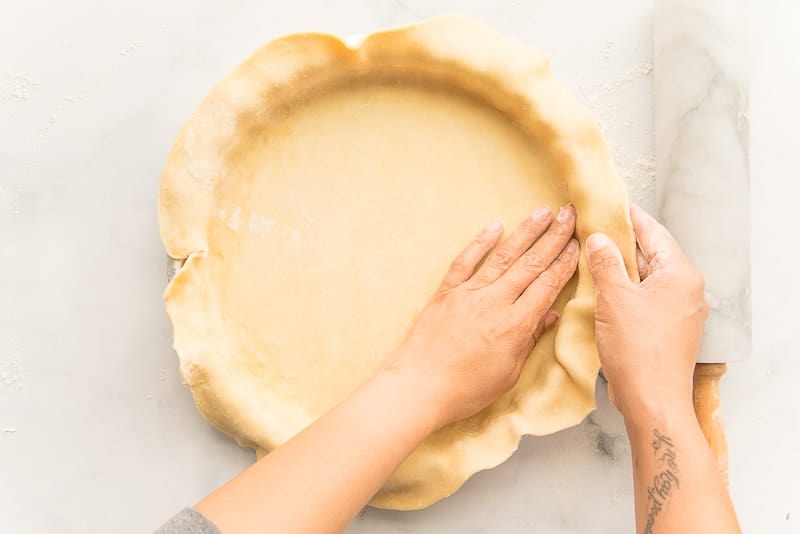
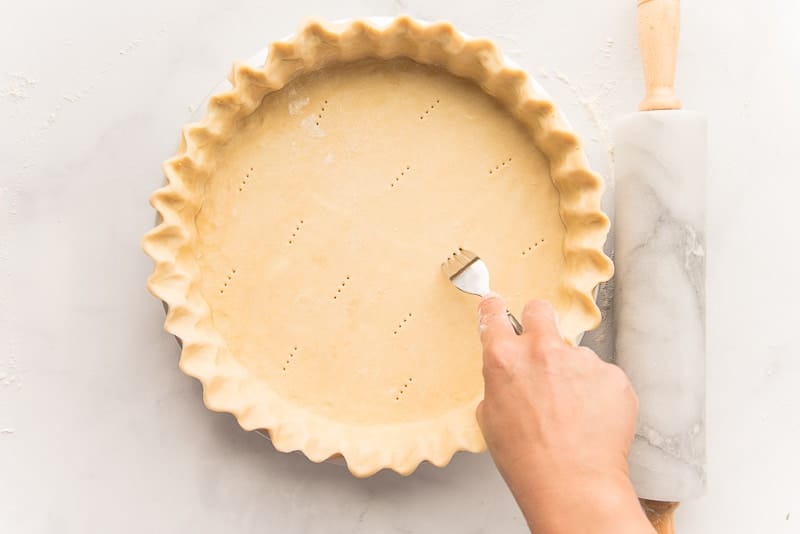
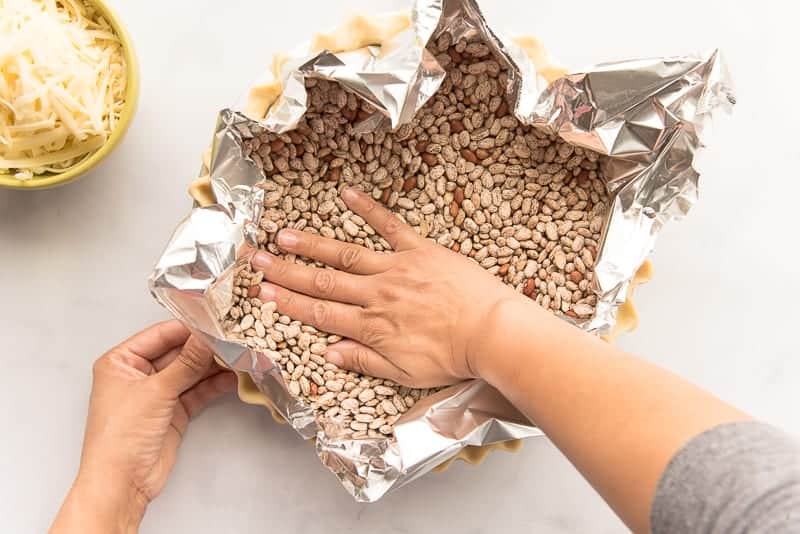
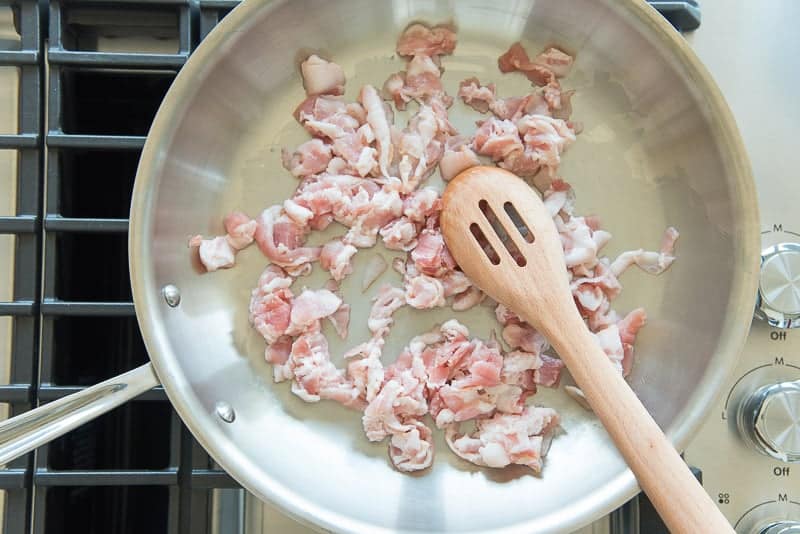
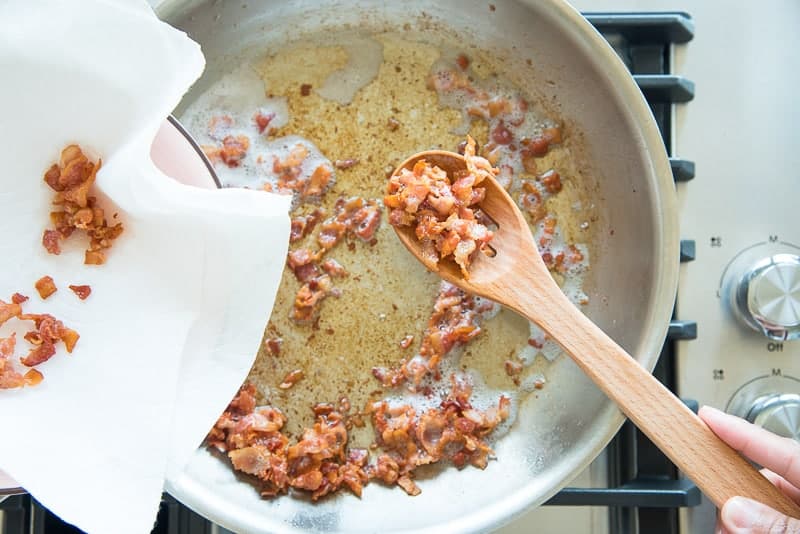
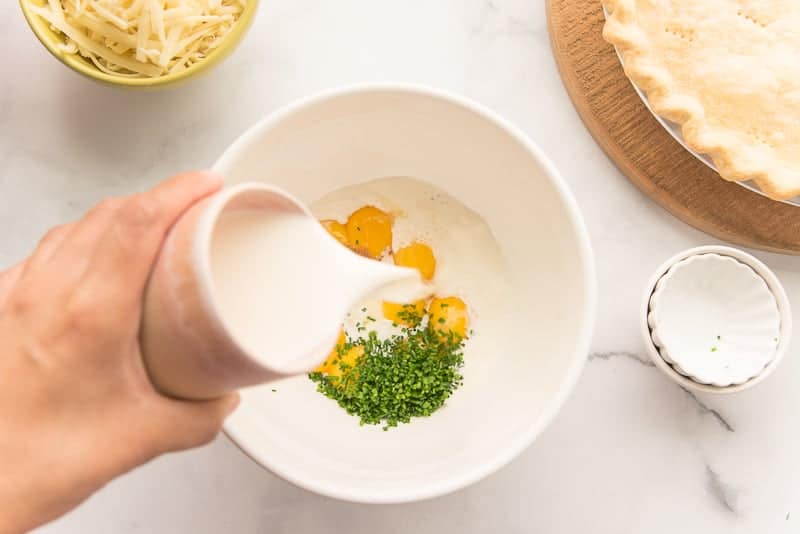
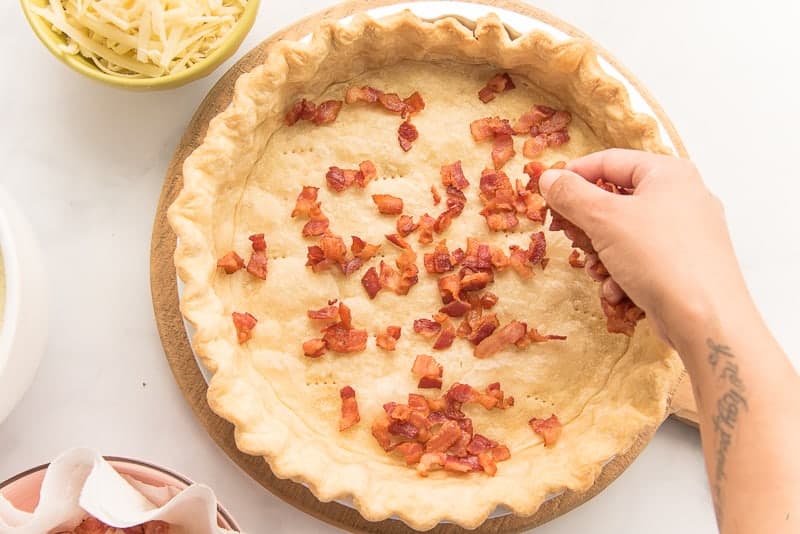
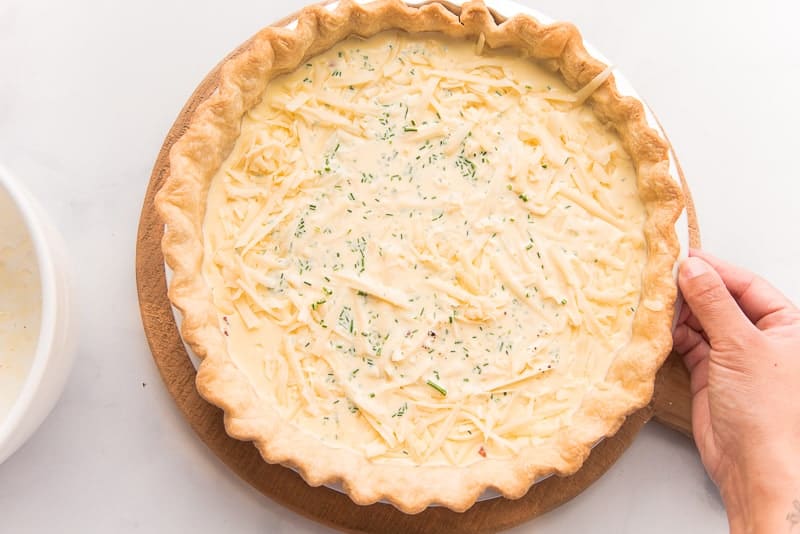
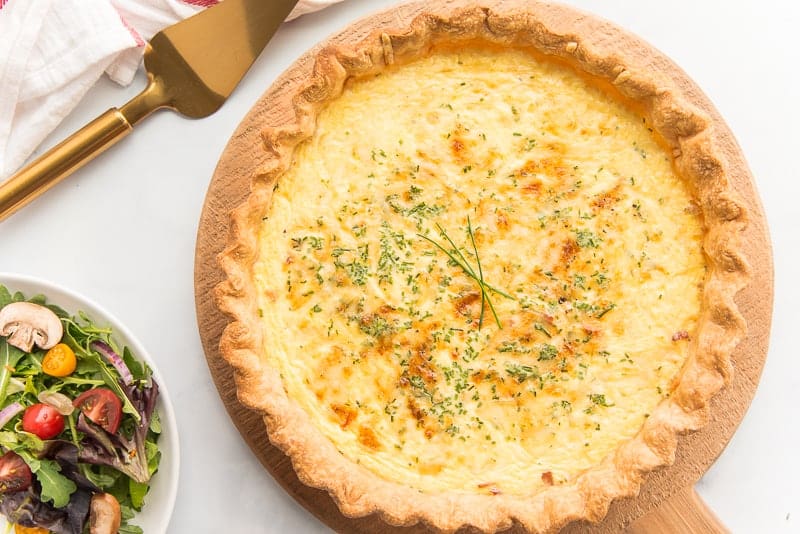
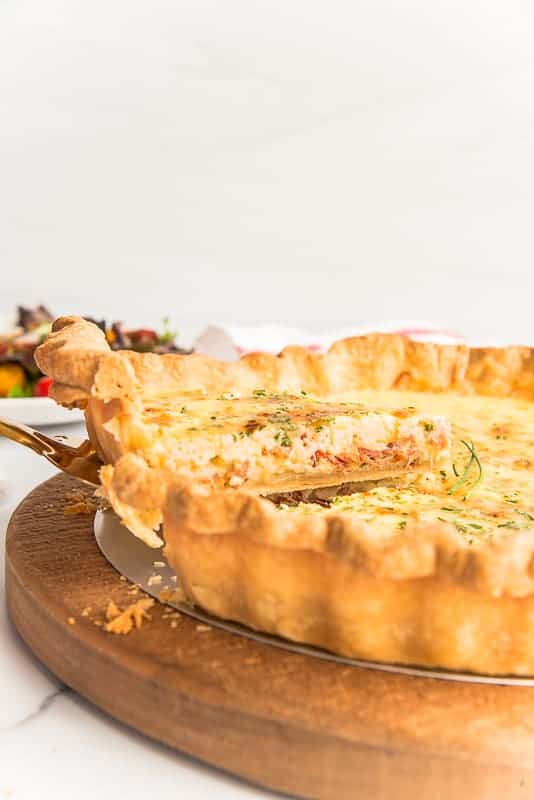

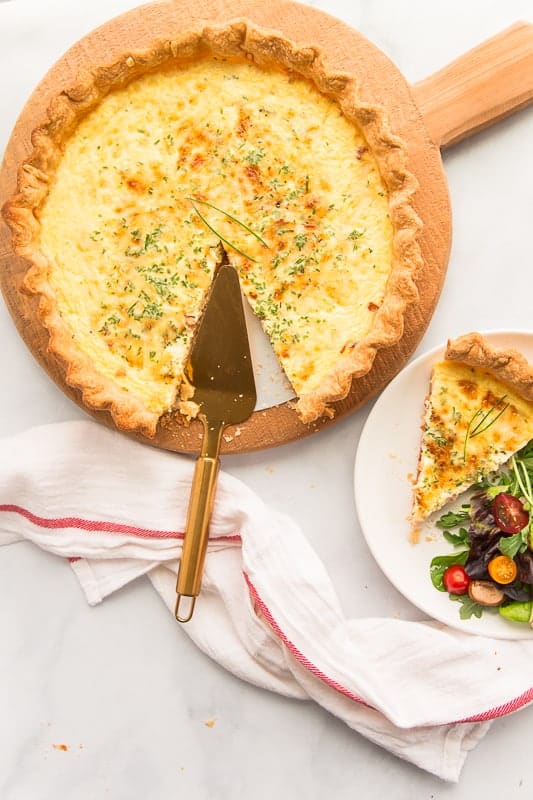

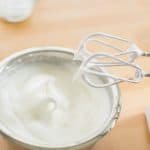
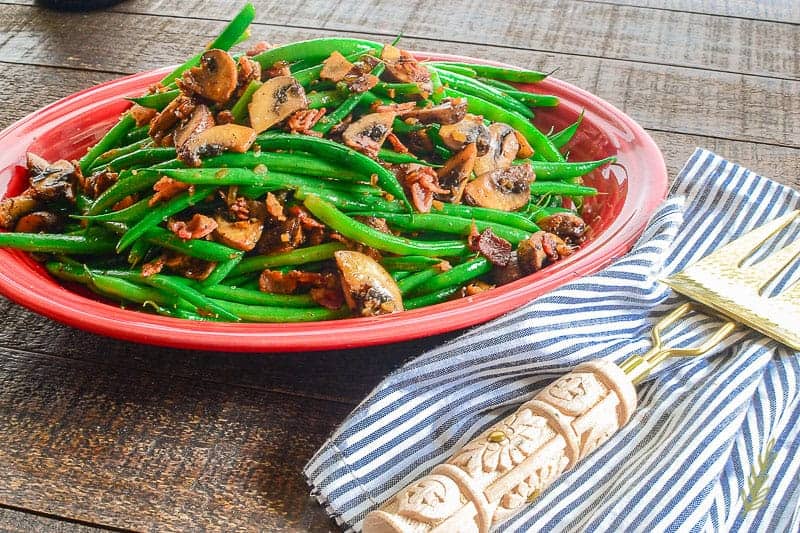

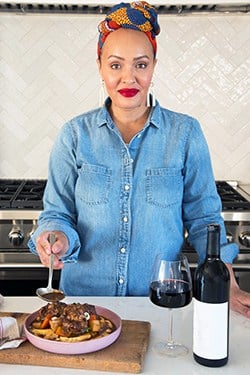
I made this recipe exactly as written. It sounds incredibly decadent compared to other quiches, and it is. Every bite is smooth, creamy and beautifully flavored. This is a showcase quiche you can serve to any guest and know it will be a hit.
It is one of my daughter’s favorites, Heidi. Thank you!
This quiche is absolutely divine! Thank you for the detailed instructions. I added prosciutto and Gouda cheese and it turned out incredible!
I made this quiche for a ladies brunch I hosted this past weekend. We had such AMAZING reviews! It was so “homey” and comforting, and full of delicious flavor.
Your blind baking tips were spot on. My quiche came out flawlessly!
Hands down the best quiche recipe I’ve made to-date! So rich, and I loved the texture. I can’t wait to make this again.
For some reason I am always quite intimidated when it comes to making quiche but, this recipe was so easy to follow and mine came out amazing! Thanks for sharing.